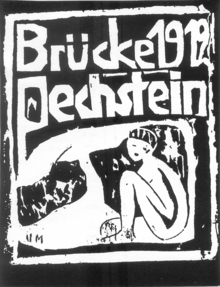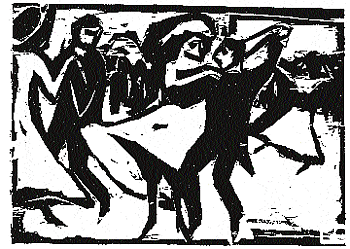EXPRESSIONISM - History, Causes, Artists, Field Sketching
- artedelic
- Oct 26, 2015
- 5 min read
EXPRESSIONISM - a modernist movement that originted in Germany in the beginning of the 20th century.
Expressionism seeks to present the world in a solely subjective perspective, and is a reaction to positivism, realism and impressionism. It reflects the widespread anxiety of humanity's increasingly discordant relationship with the world, the lost feelings of authenticity and spirituality. The movement created new standards in the creation and judgment of art---not as a depiction of the external world, but rather a sensation that comes from within the artist. The character of the artist's feelings becomes more important than an analysis of the composition. They used radical distortion to produce vivid emotional effects.
It is considered the exact opposite of Impressionism, as it strives to convey personal feelings, whereas Impressionism sought to reproduce nature, especially the effects of sunlight. Expressionists felt that Impressionism did not allow sufficient expression, as it was deemed too superficial.
It can be argued that expressionism is more of a general style than a movement, as its characteristics---to emphasise emotions over represantational qualities---really began in prehistoric cave paintings, and then later continued by artists such as El Greco and modern practicioners like Kandinsky and Matisse. The first distinct style of expressionism was fauvism, a movement that emerged in Paris, 1905, led by Henri Matisse. Fauvism favoured unnaturalistic, oversaturated colour palettes over the realistic qualities retained by the Impressionists. However, Expressionism really took root in Germany, with groups such as Die Brücke and Der Blaue Reiter. Abstract expressionism originated in the USA, though it is a very general term that houses artists with radically varying styles, from artists who attack their canvases like drip-painter Jackson Pollock, to artists who choose to convey emotions through fields of colours, like Mark Rothko.
Characteristics:
- representational accuracy is sacrificed or distorted for strong outlines and bold colours
- simpler and more direct compositions
- thick impasto paint
- loose, freely applied brushstrokes to reflect the artist's emotional or mental state
- occasional symbolism
- unnaturalistic colour palette
- emotionally agitated paintings
EDVARD MUNCH
12 Dec 1863 - 23 Jan 1944
Edvard Munch was a Norwegian artist and a key pioneer of expressionism. His paintings often depicted anxiety, isolation, rejection, sensuality and death. These themes reflect his tragic life: a childhood under an morbidly strict priest father, his mother's and favourite sister's deaths. He would later write, "I inherited two of mankind's most frightful enemies—the heritage of consumption and insanity."
Munch had a personal neurosis, especially when it came to women. He obsessively pursued them but was constantly turned down. This influenced the context of women in his paintings---they were often depicted sucking the lifeblood out of men with a kiss (see: "Vampire").
"We should paint living people who breathe, feel, suffer and love."
In 1908 he suffered a nervous breakdown and was admitted to a clinic. When he returned to oil painting, his works were less pessimistic (though man do not feel they were as good as his works before 1908). He then proceeded to become one of the top modern artists in Europe of the time.
His most famous work, The Scream, came to him when he was walking along a path and, feeling ill, stopped to rest. The sun was setting, and the cloud were turning "blood red", and Munch claimed he heard "an infinite scream passing through nature".
AFFANDI
1907 - 23 May 1990
Probably one of the most famous Indonesian artists, Affandi's signature style is to paint directly by squeezing paint onto canvas. He came to this technique one day, when he was trying to draw a line, but couldn't find a pencil. Frustrated, he proceeded to directly apply paint from the tube. To his amazement, the painting appeared more alive. He said that he felt more freedom when he was using his own hands instead of a paintbrush. The piece was later named "Affandi dan Cucu Pertama" or "Affandi and his First Grandchild". It featured Affandi and an infant, both naked in a background of stars.
He was fascinated by the Javanese wayang (shadow puppets) and followed his family to Batavia, all while improving his drawing and oil-painting skills. He worked odd jobs, sometimes as a housepainter or billboard artist, and would save up leftover paints for personal use.
"... (beautiful things) do not necessarily provide inspiration for my work. My subjects are expressive rather than beautiful."
DIE BRÜCKE
1905 - 1913
Die Brücke, or "The Bridge", was a group formed by German Expressionists in Dresden, 1905. They are sometimes compared to the Fauvists, sharing interest in primitivist art. Die Brücke used crude drawing techniques and rough figure painting, often urban scenes, representations of the modern city that reflect the negative psychological effects of urbanisation (ex: loneliness, alienation) and sought to use prostitutes as symbols of capitalism's role in the emotional distancing of individuals within cities.
It was founded by four Jugendstil architecture students: Fritz Bleyl, Erich Heckel, Ernst Ludwig Kirchner and Karl Schmidt-Rotluff. Its name, Die Brücke, symbolised the link, or bridge, that they would form with art of the future.
Their inspirations include social concern, angst, Paul Gauguin, African and Oceanic art, tribal motifs, and fauvism.
Its members began to divide because of the nervous pre-war atmosphere in Germany and claustrophobic tension. They voluntarily disbanded in 1913. In the 30s, several Die Brücke artists were executed by the Nazis for producing "degenerate art".
SKETCH HUNTING
Because internet references are not enough, and I like trains (as if you can't tell). As with the Expressionists, I wanted to explore the psychological effects of urbanisation, but with an added "modern" twist.
I took the train to Tanah Abang, intending to start once I get there. But it was hard to resist the rhythmic motion of the train, and standing up, I had a pretty good view, so I just started sketching people. Swaying and being banged against train walls (the trains were going faster than usual today, I assume it's because the drivers wanted to watch MotoGP) was not pleasant, but it actually lended some interesting qualities to the sketches. My lines were less stif, results were more "emotional".
Click on image to see full size.
And here is my sketch for the expressionist piece I'll be doing next week:

The experience of doing sketches in situ was quite different. For one, everything is in motion. You have to draw quickly, and don't have time for things like, "Is that line vertical or slightly angled?" or "Do I start with the nose or the eyebrows?" Art becomes spontaneous, which I like. Second, it gives you a different feeling. By experiencing the locations and the people, you gain an insight into what you're actually drawing, because the subjects you draw aren't flat pixels---they're breathing, talking (hopefully not to you, though I did get some), walking, living beings.
All in all, a pretty interesting day, something I'm looking forward to do more often.


















































Comments